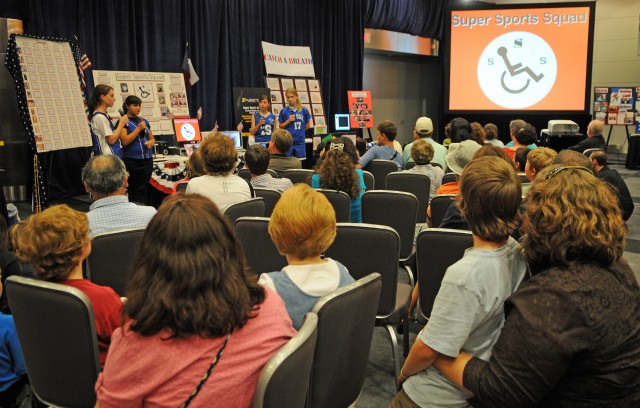WASHINGTON (Army News Service, July 7, 2009) -- More than 100 middle-school students along with their families from across the country spent last week here preparing their entries for final judging in the Army's seventh annual eCybermission National Showcase where the winners received $5,000 each in savings bonds.
ECybermission, a Web-based science, math and technology competition, had more than 2,005 teams nationwide made up of 12,000 students of sixth, seventh, eighth and ninth grades. Their online research focused on proposed solutions to their local community's challenges and concerns. Students were encouraged to collaborate using discussion forums, chat rooms and instant messaging.
"We ask the students each year to find a challenge or issue in their home communities which they can propose a solution to using math, science, engineering or technology and then we ask them to follow the scientific method in proposing a solution," said Michael Doyle, PhD., director of the eCybermission program.
"After they've focused on an issue, they propose a solution, a hypothesis, do the research and some experimentation to see if in fact their hypothesis is true, then make their recommendations and write a scientific paper which is presented to the judges," Doyle said.
At the regional as well as the national finals the judges use criteria that include best innovation in science, teamwork, how well the teams communicated their ideas and their application of science and technology.
The 2008/2009 competition had projects that dealt with the use of nitrates and fertilizers in water and the effects it has on people, crops, watersheds and aquatic life, loss of species that live along the East Coast as well as the erosion issues.
Issues studied by teams from farming communities included invasive species that destroy crops and the need to protect the Ogallala Aquifer, which provides 30 percent of the nation's ground water for crop irrigation to the national issue of childhood obesity studied by a team from a non-rural community.
Doyle said the Army sponsors the program because the American way of life as well as the country's national security is based on the ability to use science and technology.
"We need that next generation of scientists, physicists, chemists and engineers who are going to study those subjects because if we don't at some point, it will become a national crisis when we can't replace our current workforce because we haven't produced enough of those professionals at our colleges," he said.
The national first-place winning teams and a synopsis of their projects follows:
Sixth Grade National 1st Place Team: "Dragonface," Charlotte Latin School, Charlotte, N.C. The team's objective was to make Halloween costumes less flammable. They had read several articles about children being badly injured by fires caused by jack-o-lanterns, and after researching possible solutions, attempted to create a borax solution that would protect the costumes. The students soaked costumes in the solution and with the help of a local fire department, recorded the time it took for each of the materials to burn. Although they found the Borax solution didn't protect the polyester costumes, they did find it caused cotton to burn more slowly. The students were interviewed by a local television station and hope to continue spreading awareness about the dangers of flammable Halloween costumes.
Seventh Grade National 1st Place Team: "BabyBots," Stone Middle School, Melbourne, Fla. The team looked into the problem of floodwater contamination in their area. The students conducted experiments on three living organisms to see if they were affected by copper, fertilizer, unused motor oil and E. Coli, which is often present in flood waters. The students found that diluted amounts of toxins can have a negative effect on living things. The "BabyBots" plan to use the information to conduct outreach to their community about the dangers of contaminated floodwater and plan to create an inexpensive home floodwater test kit.
Eighth Grade National 1st Place Team: "Super Sports Squad," Pin Oak Middle School, Bellaire, Texas. The team put together a program to include children with special needs in its school's sports programs and extracurricular sports activities. The students created lesson plans using adaptive physical education for soccer, kickball, tee ball and basketball. They found their participants motor skills increased throughout the course of their program and hope to promote it to others in their community.
Ninth Grade National 1st Place Team: "Catch a Breath," All Saints Regional Catholic School, Manahawkin, N.J. The team investigated indoor air pollution in its community and school. The students used an indoor air quality monitor and tested the carbon monoxide, carbon dioxide, humidity, temperature and dew points in public places as well as at their school. They found that the carbon dioxide level in their school was twice the "safe level," as stipulated by the Environmental Protection Agency. The students then invented a carbon dioxide monitor for their school and hope to get it patented to be used in all schools.
Registration for the 2009-2010 eCYBERMISSION competition opens Aug. 1.


Social Sharing